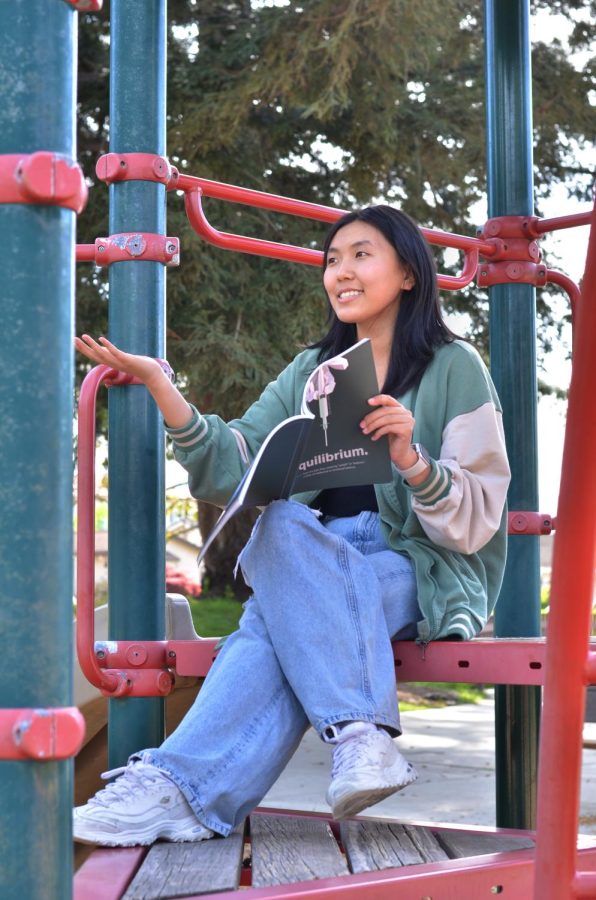Humans of Harker: Finding equilibrium
Catherine He approaches life with balance and creativity
“I’ve found that economics stretches into every corner of how society works: the institutional level, behavioral level, the rational human being. Like game theory, it’s a really interesting way to analyze the decisions being made on multiple levels, and it also helps me not make impulsive decisions that I would be making otherwise,” Catherine He (’22) said.
Flipping through this past year’s issue of Equilibrium, the upper school’s economics magazine, Catherine He (‘22) reminisces on the production as the co-Editor-in-Chief, reflecting on the design, illustrations and, of course, the student writings.
“I’ve found that economics stretches into every corner of how society works: the institutional level, behavioral level, the rational human being,” Catherine said. “Like game theory, it’s a really interesting way to analyze the decisions being made on multiple levels, and it also helps me not make impulsive decisions that I would be making otherwise.”
While her involvement in economics and Equilibrum stemmed from her desire to branch out from her STEM-heavy courses and extracurriculars, Catherine also found a means to explore another interest: graphic design, which she further developed through other opportunities in organizations such as DECA and the Women in Stem (WiSTEM) club.
Her work, whether it be a sweatshirt design or an informational Instagram post, all goes through the same process. Catherine first develops a color scheme, then blocks in shapes and creates vector images, and finally, she will “just let it flow.”
“In terms of graphic design, I’ve grown to love whitespace more,” Catherine said. “My work before was very cluttered because I wanted to fit everything in. But now, I really do think less is more, and that extends to all parts of life as well.”
Victoria Han (‘22), Catherine’s DECA partner and close friend since middle school, notes that Catherine’s creativity extends beyond the canvas, reaching into her interpersonal and presentation skills.
“She’s definitely the more creative one,” Victoria said. “She thinks of cool ideas, including in her role plays, like acronyms and graphics. She’s so good at thinking on her feet during roleplays.”
Close friend Syna Gogte (‘22) emphasized Catherine’s personal growth from a relatively shy person in middle school and freshman year to a more confident leader who also makes time to enjoy moments with friends, despite her commitments.
“Now, she can be very outspoken and is good at leading a large group of people, especially when it comes to communicating,” Syna said.
After returning to in-person learning at the beginning of the school year, Catherine’s adviser Mark Janda noticed a marked difference between her sophomore and senior self.
“She grew confident in her voice,” Janda said. “When she started here, she was pretty quiet. She is not quiet anymore. And it’s not that she’s just suddenly social or anything. It’s that I think she feels secure in her own skin.”
Janda commends Catherine most notably on her ability to find an equilibrium between her rigorous academic and extracurricular workload and a normal high school experience.
“She’s someone with amazing grades but a great sense of humor and never too stressed,” Janda said. “She held everything in balance and is so happy-go-lucky. She can also mix it up and giggle with anyone. She’s never going to be the kind of person who attracts a bunch of attention to her. She is going to be in the mix and lowkey silly.”

Emily Tan (12) is the co-editor-in-chief of The Winged Post. This is her fourth year on staff, previously serving as the Winged Post features editor, and...


















![“[Building nerf blasters] became this outlet of creativity for me that hasn't been matched by anything else. The process [of] making a build complete to your desire is such a painstakingly difficult process, but I've had to learn from [the skills needed from] soldering to proper painting. There's so many different options for everything, if you think about it, it exists. The best part is [that] if it doesn't exist, you can build it yourself," Ishaan Parate said.](https://harkeraquila.com/wp-content/uploads/2022/08/DSC_8149-900x604.jpg)




![“When I came into high school, I was ready to be a follower. But DECA was a game changer for me. It helped me overcome my fear of public speaking, and it's played such a major role in who I've become today. To be able to successfully lead a chapter of 150 students, an officer team and be one of the upperclassmen I once really admired is something I'm [really] proud of,” Anvitha Tummala ('21) said.](https://harkeraquila.com/wp-content/uploads/2021/07/Screen-Shot-2021-07-25-at-9.50.05-AM-900x594.png)







![“I think getting up in the morning and having a sense of purpose [is exciting]. I think without a certain amount of drive, life is kind of obsolete and mundane, and I think having that every single day is what makes each day unique and kind of makes life exciting,” Neymika Jain (12) said.](https://harkeraquila.com/wp-content/uploads/2017/06/Screen-Shot-2017-06-03-at-4.54.16-PM.png)








![“My slogan is ‘slow feet, don’t eat, and I’m hungry.’ You need to run fast to get where you are–you aren't going to get those championships if you aren't fast,” Angel Cervantes (12) said. “I want to do well in school on my tests and in track and win championships for my team. I live by that, [and] I can do that anywhere: in the classroom or on the field.”](https://harkeraquila.com/wp-content/uploads/2018/06/DSC5146-900x601.jpg)
![“[Volleyball has] taught me how to fall correctly, and another thing it taught is that you don’t have to be the best at something to be good at it. If you just hit the ball in a smart way, then it still scores points and you’re good at it. You could be a background player and still make a much bigger impact on the team than you would think,” Anya Gert (’20) said.](https://harkeraquila.com/wp-content/uploads/2020/06/AnnaGert_JinTuan_HoHPhotoEdited-600x900.jpeg)

![“I'm not nearly there yet, but [my confidence has] definitely been getting better since I was pretty shy and timid coming into Harker my freshman year. I know that there's a lot of people that are really confident in what they do, and I really admire them. Everyone's so driven and that has really pushed me to kind of try to find my own place in high school and be more confident,” Alyssa Huang (’20) said.](https://harkeraquila.com/wp-content/uploads/2020/06/AlyssaHuang_EmilyChen_HoHPhoto-900x749.jpeg)



